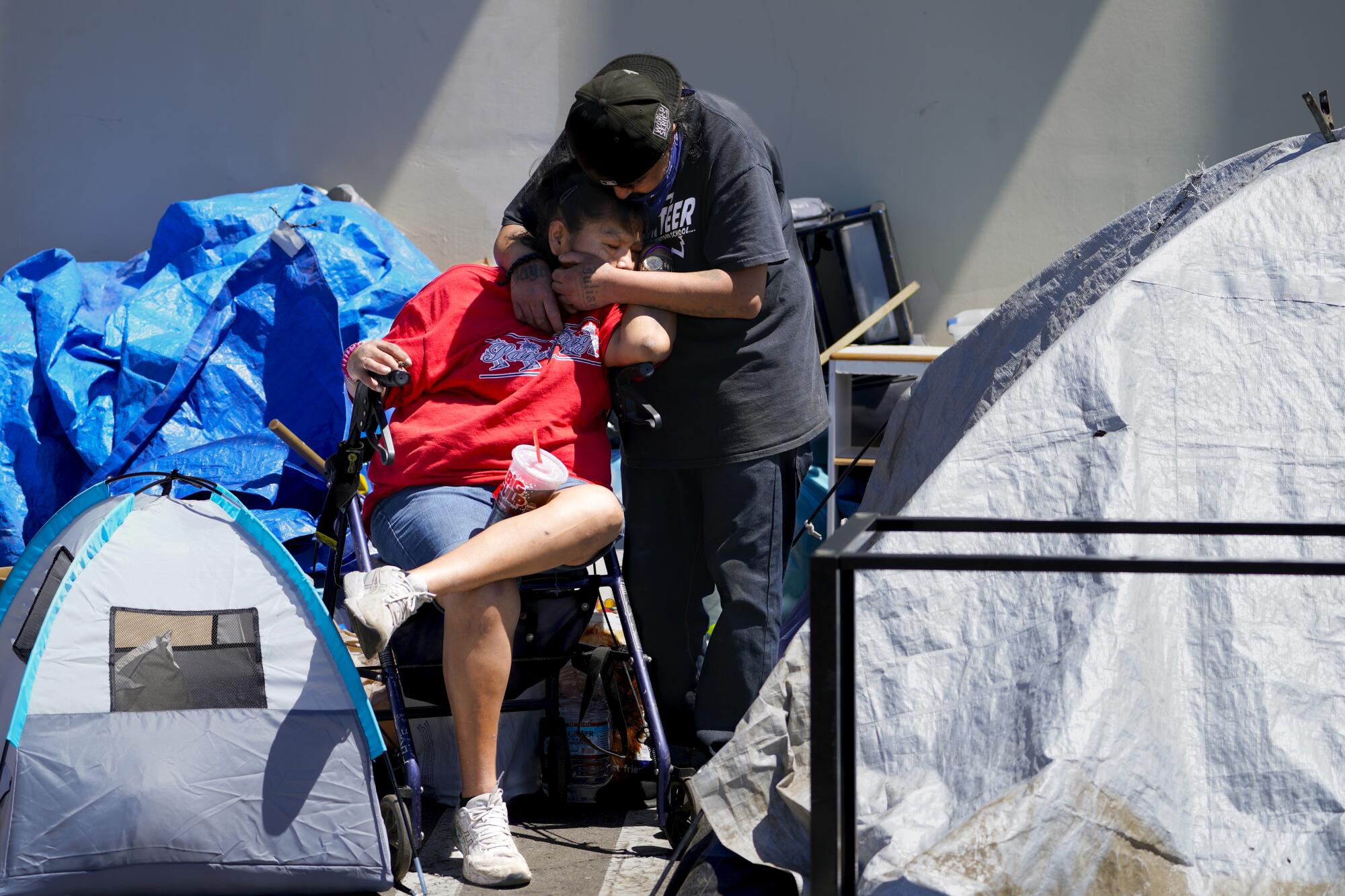
‘It was just this year and a half of sliding and sliding through all the gate checks,’ said one man
One evening last September, Patrick Gilligan drove to a rest area north of Oceanside.
He parked his Jeep, lowered the back seat, spread out a sleeping bag and laid down.
Gilligan mentally replayed his last few decades. There had been childhood abuse, service in the U.S. Marine Corps., a divorce and a layoff and countless other decisions, big and small, that had somehow led him to having no bed of his own.
In that moment, Gilligan became part of a countywide trend that has remade public policy, dominated elections and cost millions upon millions of dollars.
March was the 24th consecutive month the number of homeless residents connected to housing was eclipsed by the number of people who lost a place to stay for the first time, according to a new report from the Regional Task Force on Homelessness.
There were 1,226 people housed, while 1,337 became newly homeless.
The picture is hardly better further back. Since October 2021, when the task force began releasing this data, there have been just two months when the crisis didn’t grow. Even then, the gains were minor: Only nine more people got housing than those who lost a steady roof in March 2022.
“There’s just not enough housing at a price point that people can afford,” said Jennifer Nations, managing director of the Homelessness Hub research lab at UC San Diego. “This is especially evident in the numbers of first-time homeless,” she added, many of whom are older adults.
A growing body of research has found that areas with high costs of living tend to have more people on the street, and the city of San Diego recently logged some of the highest rents and the biggest jump in home prices nationwide.
Combine that with addiction and mental health struggles — a survey last year found around a fifth of those without shelter had a substance use disorder and more than a quarter reported serious mental health diagnoses — and the ripple effects are profound.
“It’s horrible,” Moe Girton, owner of the Hillcrest restaurants Gossip Grill and Barrel & Board, said about nearby encampments. Sidewalks were stained with feces. Needles could be found by asphalt. A man had recently tried to burn down one of her buildings, she added.
Stefan Chicote, general manager of the nearby restaurant Baja Betty’s, said confrontations with unstable passersby had led him to hand out pepper spray to staff. “It feels like nobody’s on our side.”
Perhaps no recent case better embodies the ways living outside can intersect with crime than the death of a 41-year-old earlier this month in El Cajon. Police said both the victim, a man found with “blunt force trauma,” and the alleged killer, a 37-year-old arrested last week, were homeless.
People are dying from fentanyl and hypothermia and heart disease. A decade ago, around 150 homeless individuals died annually, according to the county medical examiner. Last year, the toll was 624, an average of one person every 14 hours.
Even as the U.S. Supreme Court weighs whether to give local officials more leeway to clear encampments, leaders around the region have boosted penalties for living in tents.
Poway passed a camping ban. Chula Vista may be next. San Diego’s ordinance corresponded with a drop in downtown’s population and more people asking for shelter, yet there are nowhere near enough beds and some proposals to increase capacity face an uncertain future.
One plan to convert an empty warehouse into a 1,000-bed facility has slowed amid apparent concerns over the real estate deal. A separate proposition to host hundreds of people on a lot by the airport could meet a possible legal challenge.
In the meantime, people sleep in trucks, against horse stalls and under tarps.
On Tuesday in Point Loma, Sheila “Chye” Nezzie, 45, sat on a walker across the street from a Goodwill. Two years ago, she and her husband were living in a riverbed. Now they stay in a tent on Midway Drive.
Nezzie said her partner, Juan “Chino” Cota, had advanced stomach cancer but struggled to find regular medical care.
“I just want him to be comfortable,” Nezzie said and began to cry. Cota stopped re-arranging cardboard boxes and cradled her face in his hands.
Gilligan, the 59-year-old at the rest stop, had high hopes when he moved a few years ago from Massachusetts to North County for a job selling financial software.
He arrived in January 2020. The pandemic showed up soon after. Midway through the next year, he said the company couldn’t afford to keep him on.
Gilligan left his apartment in Solana Beach. Hotels drained his savings. He tried living with one friend but the relationship crumbled. Child support bills mounted.
“It was just this year and a half of just sliding and sliding through all the gate checks,” he said.
Gilligan was also wrestling with the fallout of being molested as a child, and a recent report from a psychologist found signs of post traumatic stress. He wondered if it was worth staying alive.
The turnaround came when Gilligan called the VA.
They connected him with a range of support services, including the nonprofit People Assisting the Homeless, and he landed a downtown apartment. Gilligan briefly received rental assistance but now lives off his new job as director of development with Lived Experience Advisers, a local homelessness advocacy group.
“I thought I knew what homelessness was, but I didn’t,” he said. “The guys you’re seeing out in public, the ones that are talking to themselves and harassing people walking by, that’s actually the tip of the iceberg.”
Get Essential San Diego, weekday mornings
Get top headlines from the Union-Tribune in your inbox weekday mornings, including top news, local, sports, business, entertainment and opinion.
You may occasionally receive promotional content from the San Diego Union-Tribune.
